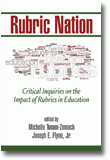
Rubric Nation
Critical Inquiries on the Impact of Rubrics in Education
Edited by:
Michelle Tenam-Zemach, Nova Southeastern University
Joseph E. Flynn Jr., Northern Illinois University
Published 2015
What is a rubric and how are they being used in teacher education and evaluation? When did rubrics become ubiquitous in the field of education? What impact do rubrics have on students, teachers, teacher educators, and the educational enterprise? This book is an edited volume of essays that critically examine the phenomenon of rubrics in teacher education, evaluation and education more broadly. Rubrics have seen a dramatic rise in use and presence over the past twenty-five years in colleges of education and districts across the country. Although there is a wealth of literature about how to make rubrics, there is scant literature that explores the strengths and weaknesses of rubrics and the impact the rubric phenomenon is having in reshaping education. The chapters included in this edited volume will critically reflect on the contemporary contexts of rubrics and the uses and impact of rubrics in education. Since rubrics have become indelible in education, it is necessary for a fuller, nuanced discussion of the phenomenon. Creating a book that explores these aspects of rubrics is timely and fundamental to expanding the discourse on this ubiquitous evaluation tool.
This book is not meant to be a series of chapters dedicated to best practices for creating rubrics, nor is this text meant to present all sides of the rubric discussion. Rather, this text intends to offer critical polemics about rubrics that can spur greater critical discussion about a phenomenon in education that has largely been unquestioned in the literature.
CONTENTS
Foreword, Joel Westheimer. Introduction: Why a Book on Rubrics? Problematizing the Unquestioned, Joseph E. Flynn, Jr., Michelle Tenam-Zemach, and Leslie David Burns. The Rubricization of Experience, Michelle Tenam-Zemach. The Rubricization of Teacherhood and Studenthood: Intertextuality, Identity, and the Standardization of Self, Nancy G. Patterson and Lisa M. Perhamus. Collision Course: Postmodern Progressive Composition Pedagogy and Positivist Traditional Assessment, Amy L. Masko. Rubrics Reframed: Reappropriating Rubrics for Assessment and Learning, Paul Parkison. The Sanctity of Software and Rubrics as Holy Interfaces: A Critical Software Analysis of Rubrics as Vehicles of Education Reform, Tom Liam Lynch. Standards, Rigor, and Rubrics: Prefabricated Critical Thinking, Robert Boostrom. Employing a Technology of Power: An Orientation Analysis of a Teacher Task Rubric, Conra D. Gist. Rubrics in Context, Dana Haraway and David Flinders. (Dis)positioning Learners: Rubrics and Identity in Teacher Education, Catherine Lalonde, David Gorlewski, and Julie Gorlewski. Collaboration, Rubrics, and Teacher Evaluation, Susan Dreyer Leon and Laura Thomas. Getting Teacher-Evaluation Rubrics Right, Kim Marshall. The Danielson Framework for Teaching As an Evaluation Rubric: One Size Fits None, Leslie David Burns. Racing the Unconsidered: Considering Whiteness, Rubrics, and the Function of Oppression, Joseph E. Flynn, Jr. An Afterword in Two Voices: The Tools of Destruction and Empowerment: Reflections on Creating a Book About Rubrics, Michelle Tenam-Zemach and Joseph Flynn. About the Editors. About the Contributors.
-
Paperback9781623969615
Web price: $45.04 (Reg. 52.99)
-
Hardcover9781623969622
Web price: $80.74 (Reg. 94.99)
- eBook9781623969639

- EDU000000 - EDUCATION: General
- EDU011000 - EDUCATION: Evaluation & Assessment
- EDU037000 - EDUCATION: Research
-
 (Re)Envisioning Social Studies Education Research
Current Epistemological and Methodological Expansions, Deconstructions, and Creations
(Re)Envisioning Social Studies Education Research
Current Epistemological and Methodological Expansions, Deconstructions, and Creations
-
 American Educational History Journal - Golden Anniversary Edition
Volume 50 Numbers 1 & 2
American Educational History Journal - Golden Anniversary Edition
Volume 50 Numbers 1 & 2
-
 Distance Learning
Volume 20 #3
Distance Learning
Volume 20 #3
-
 Distance Learning
Volume 20 #4
Distance Learning
Volume 20 #4
-
 Qualitative Research With Diverse and Underserved Communities
Qualitative Research With Diverse and Underserved Communities
-
 Quarterly Review of Distance Education
Volume 24 #1
Quarterly Review of Distance Education
Volume 24 #1
-
 Rekindling Embers of the Soul
An Examination of Spirituality Issues Relating to Teacher Education
Rekindling Embers of the Soul
An Examination of Spirituality Issues Relating to Teacher Education

